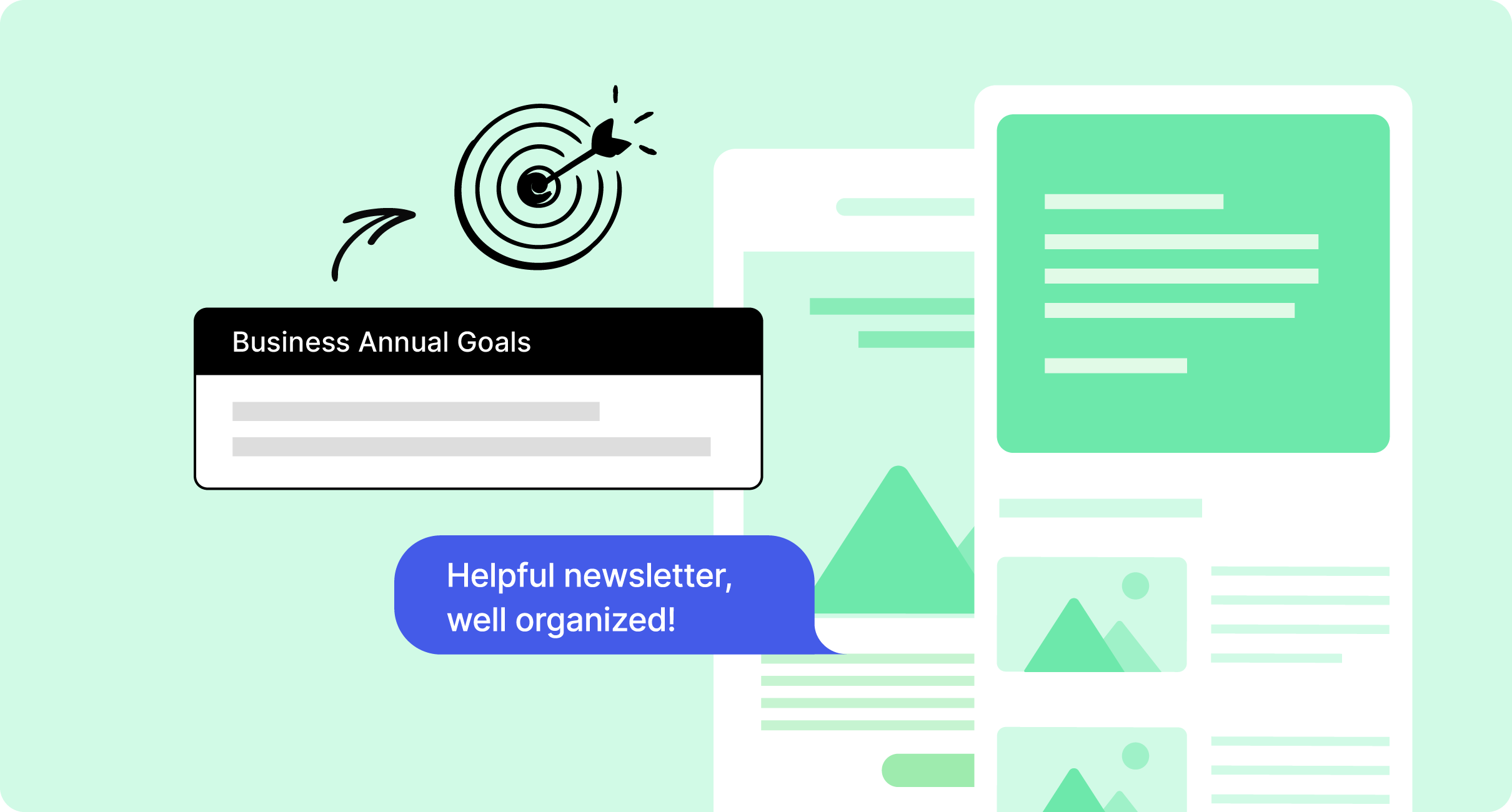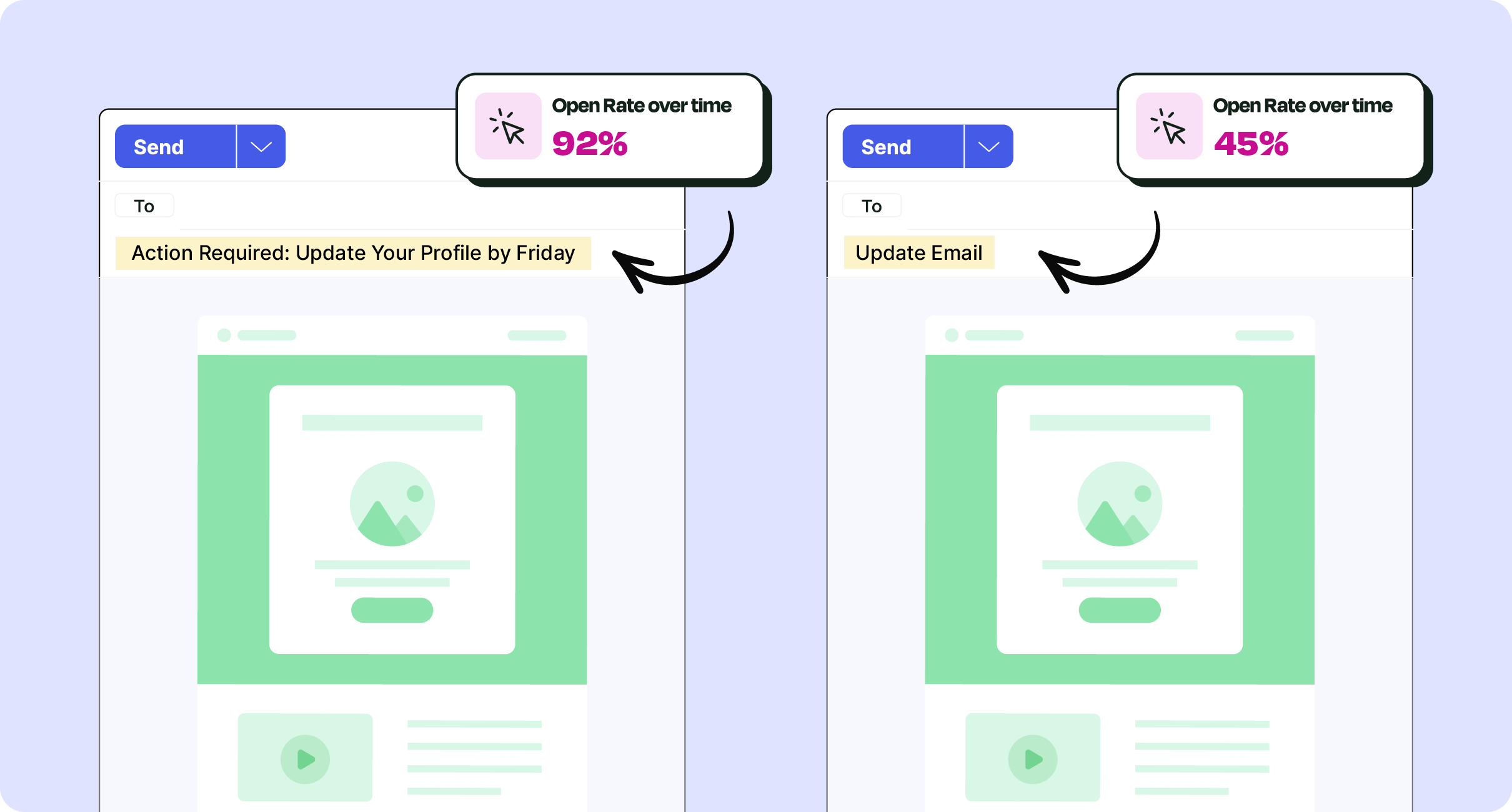As an internal communicator, I’ve experienced my fair share of exhausting, caffeine-fueled weeks where I’ve supported multiple all-staff emails on various topics (CEO updates, benefits plan changes, team restructures, and upcoming employee engagement events) all within one week.
Ad hoc sends are exhausting for the communicators working on them, and more importantly, they can cause information overload and email fatigue for those receiving them. Not to mention that without careful planning, messages can quickly contradict each other.
While there’s a time and place for the occasional one-off send (such as in an emergency), campaign-based communication helps build clarity, narrative depth, and opportunities for measurable engagement over time.
In this internal email strategy guide, you’ll learn why campaign thinking matters and how it can strengthen your overall internal comms strategy. Walk away with an easy-to-follow framework for developing internal email campaigns, benchmarks, and the tools you need to shift from tactical sending to a more strategic approach.
Take a self-guided tour of ContactMonkey
See how our key features can streamline your internal communications.
Take product tour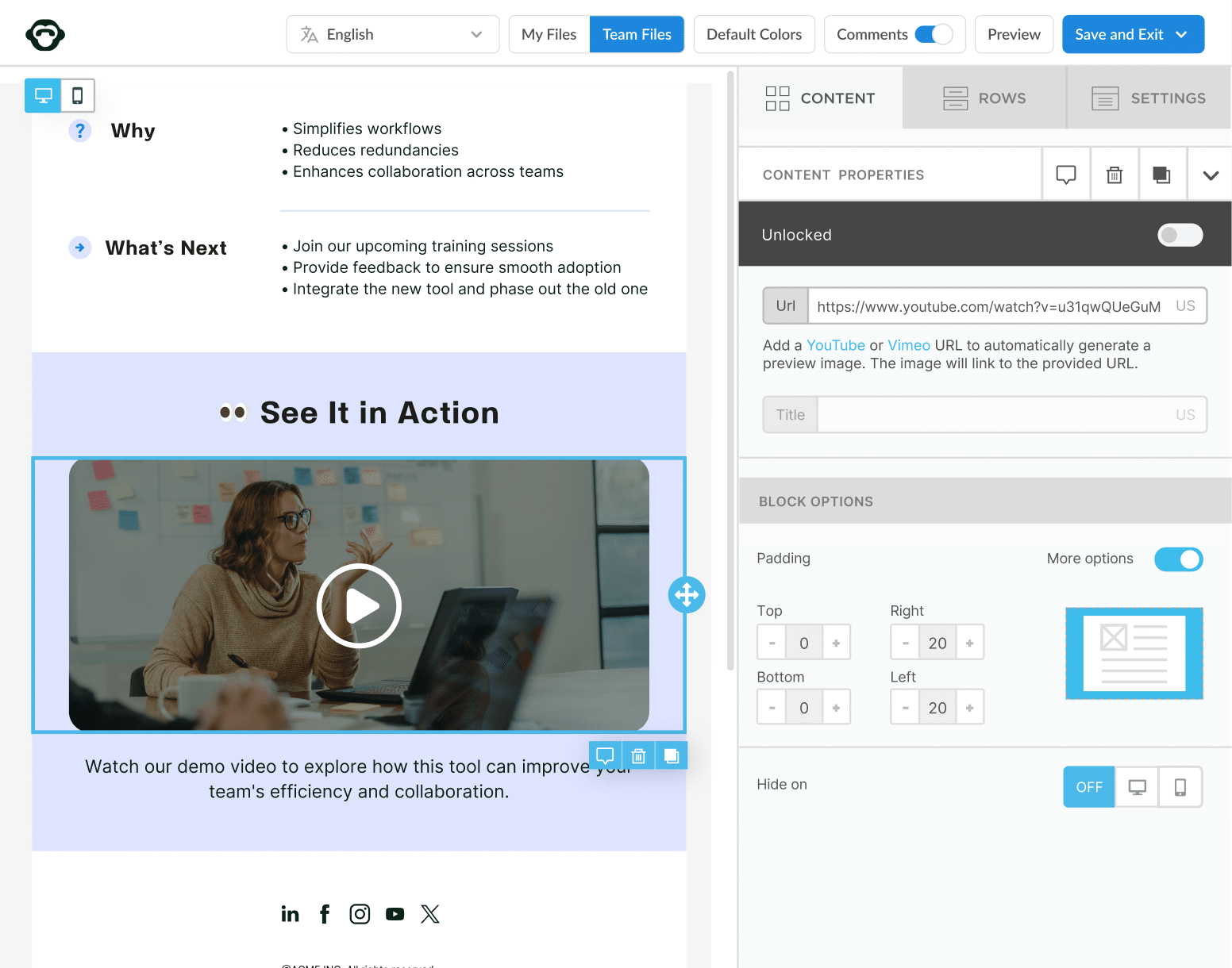
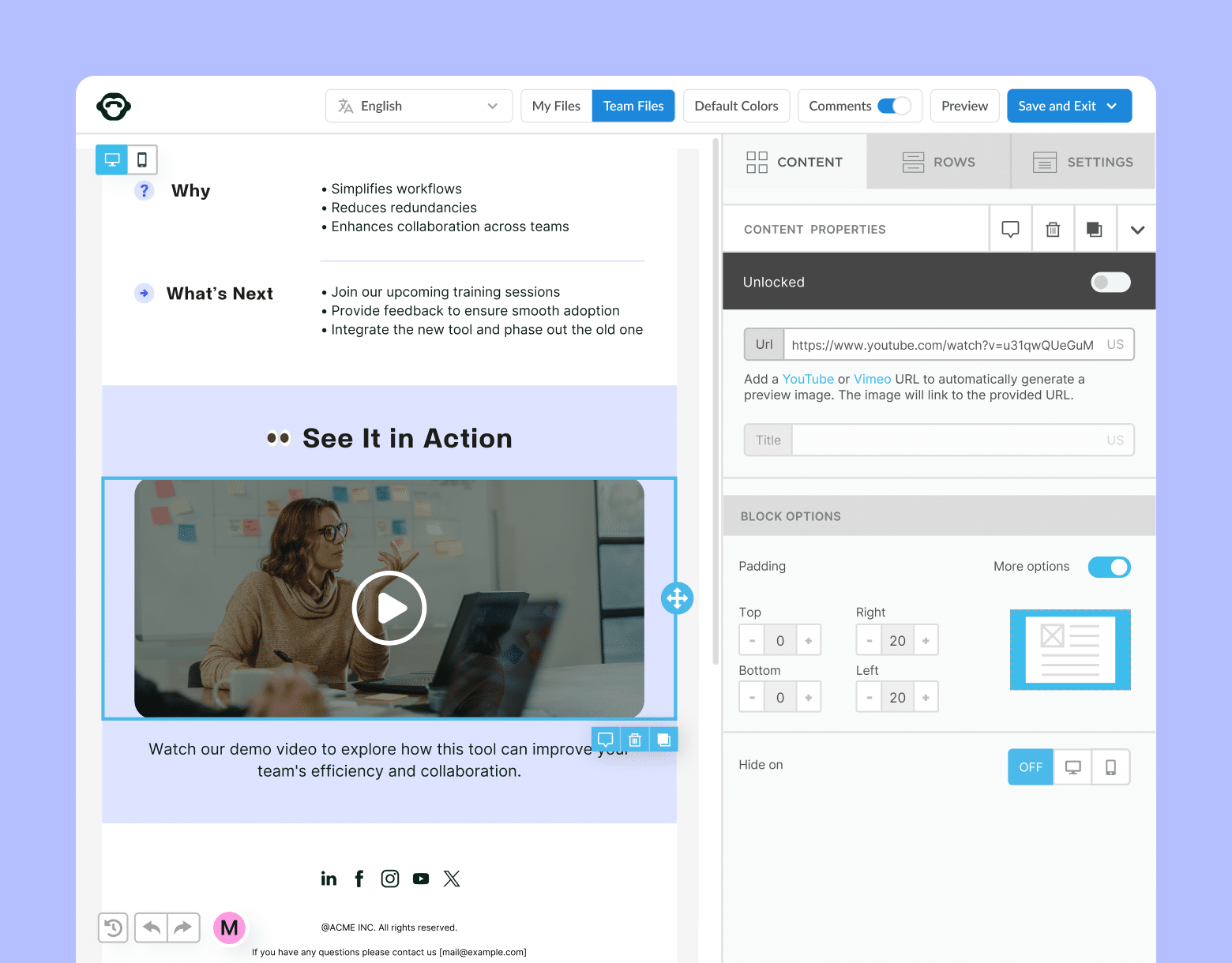
Challenges of One-Off Sends in Internal Comms
Without an intentional rhythm or story, too many ad hoc messages create noise and devalue the contents of each message. Below are three common challenges of overrelying on one-off internal emails.
Lack of consistency + missed storytelling opportunities
Without a consistent cadence, voice, and interwoven story elements, employees can’t quickly see how each message links to broader company goals or cultural themes. And without a link back to the bigger picture, employees may deem some messages as less important than others, depending on the amount of time they have, the relevance of the message, and their capacity to absorb another one-off communication.
Hard to measure ROI from fragmented efforts
Fragmented internal emails are nearly impossible to measure in terms of success and effectiveness. How can you truly know if one message leads to the results you want to see? If you use internal comms software, you can pull open rates and clicks for a one-off email. Still, these metrics alone won’t give insight into the things we hope many communications do: drive behavioral change, encourage employees to take action, or engage with content in a specific way.
And without enough data, internal communicators can’t always prove ROI, demonstrate impact to leadership, or improve future internal communications based on what didn’t work.
Employees tune out without a narrative arc
When you overrely on one-off internal email sends, your messages inherently compete with one another. Every time an employee receives a new internal email, the goal is to capture their attention. But when this becomes too frequent, employees may feel overwhelmed, disinterested, or worse, disengage.
Without an ongoing narrative or throughline tying messages together as part of an overarching strategy, internal emails can feel repetitive, transactional, uninteresting, and even irrelevant. Over time, this can result in lower internal email open rates, reduced trust, and poor alignment.
PRO TIP: Wondering what a “good” internal email open rate benchmark is? The average email open rate benchmark was 68% across more than 195,000 email campaigns sent through ContactMonkey. Find out what the open rate for your industry is in the 2025 Internal Email Benchmark Report.
Create internal emails that get opened and read
No design or technical expertise needed. Save time, increase engagement, and dazzle your employees with fun and interactive communications.
Explore email features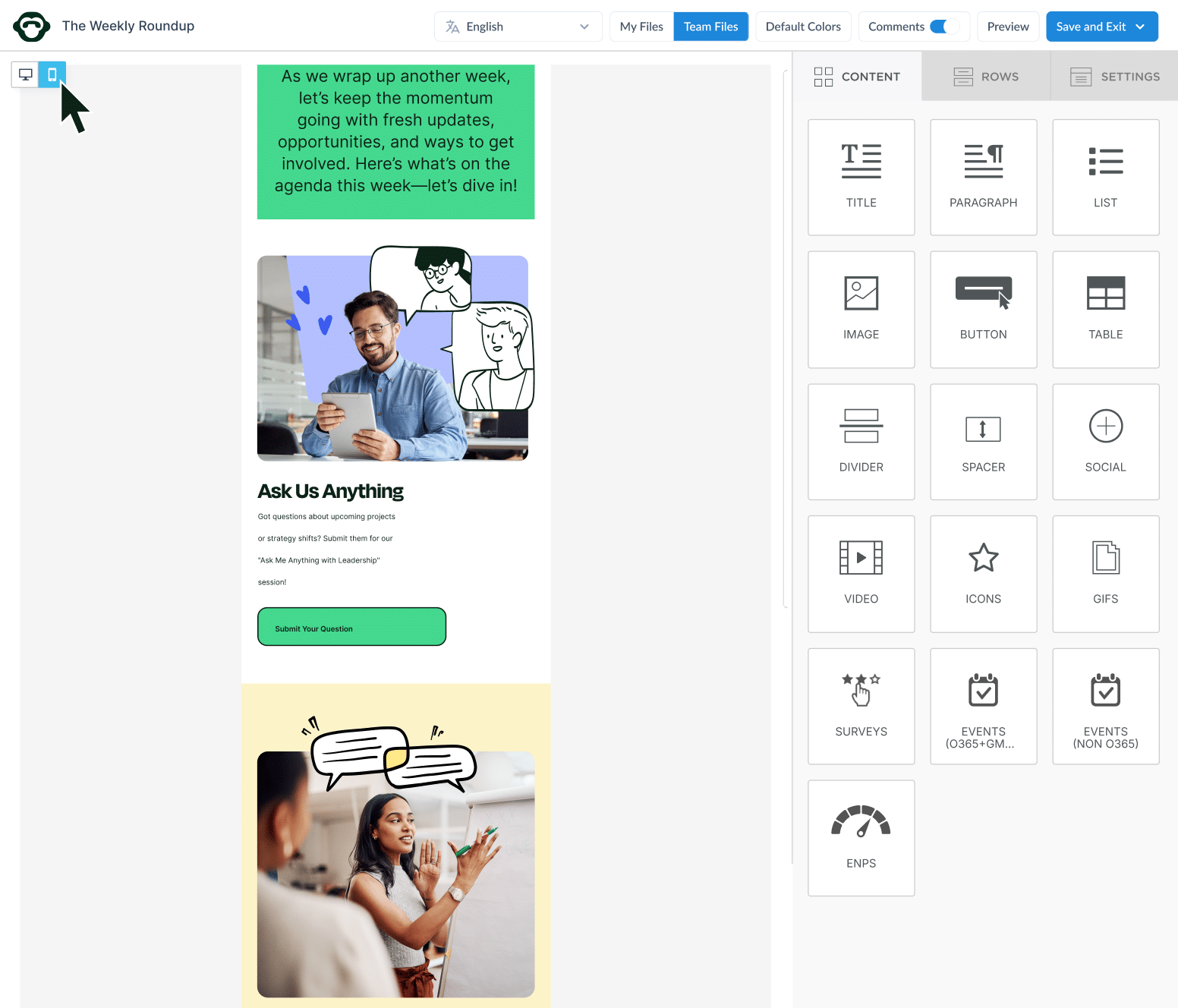
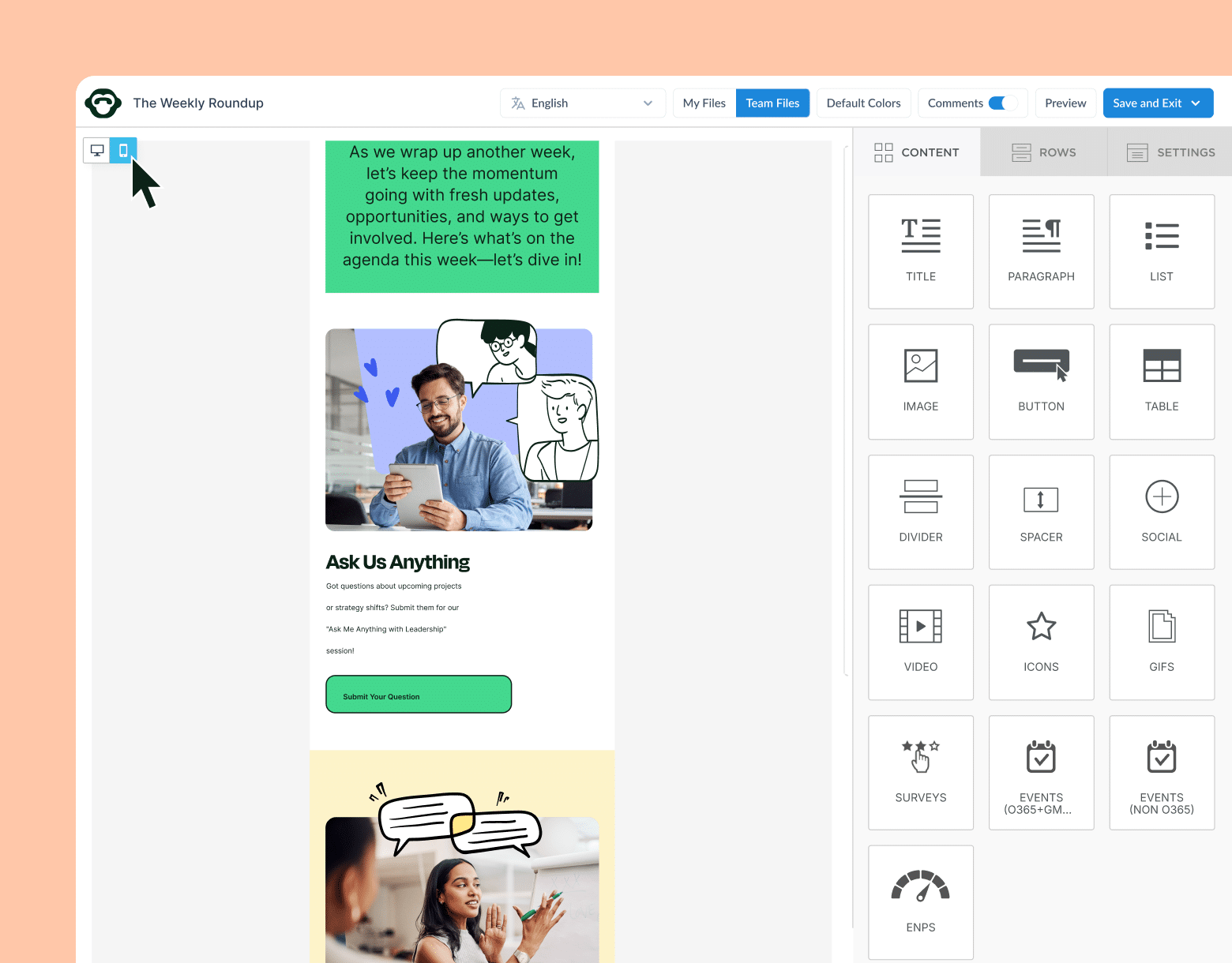
The Benefits of Campaign Thinking
Taking a campaign-based approach to internal communications ties messages together to create a purposeful experience. Here are some of the key benefits:
Reinforces core messages over time
A campaign-based strategy offers the opportunity to naturally and intentionally emphasize and reiterate key messages. In a campaign, messages build on each other, creating a stepping stone from one to the next, all without losing the foundational ties of the key messages. The process of strategically tying messages together helps employees internalize complex topics and understand how each update relates to the broader context.
It’s the difference between drafting one message and sending it multiple times with little to no changes, hoping it lands, and crafting a strategic campaign rooted in key messages to reiterate as each new message builds on the last.
Builds trust and predictability
Another underlying benefit of campaign-based messaging is that it creates predictable and consistent workflows, making it easier for employees to understand how internal communications work within the organization. When employees understand what types of messages to expect and who will send them, credibility and confidence in emails as a communication channel builds. Especially when communicating change or uncertainty, trust between leaders and employees is crucial.
Creates measurable impact on engagement metrics
Internal email campaigns offer deeper insights and more performance tracking opportunities than ad hoc emails. With structured email sequences, consistent timing, and defined goals for each message, teams can analyze various metrics to demonstrate ROI. Internal communicators can analyze email analytics, including email open rates, CTR, engagement trends, interactions, and behavioral outcomes, across an entire campaign.
Framework for Internal Email Campaigns
Shifting from one-off internal email sends to campaign-based messaging doesn’t have to be complicated or process-heavy. Internal email frequency and cadence aren’t an exact science, but this four-step internal email campaign framework can help you plan strategically and effectively:
1. Define goals (awareness, behavior change, culture)
Every effective message starts with a clear reader goal in mind. If you want your internal email campaigns to be successful, you have to define what success looks like, so you can determine whether you achieve your goals through your message.
Defining the goals and outcomes of your campaign informs the timing, tone, and measures you’ll use to evaluate success.
Unlock Internal Comms Superpowers
Discover why 10,000+ rely on us. See the internal email and employee newsletter platform in action.
Book demo

Here are some questions to consider when defining your goals and outcomes:
- What should employees do with the information we are providing? Learn? Engage? Act? Change their behavior?
- Are we creating awareness? If so, how will we measure employee understanding?
- Are we asking employees to change their behaviors? If so, what behaviors will we observe, and how will we monitor their change?
- Do we need employees to complete an action? What is the action, and when is the deadline?
Once you define your goals and outcomes, you can determine which metrics (e.g., open rates, behavioral changes, response count, interactions, etc.) you will use to measure your performance.
An important note about measuring behavioral changes: There are instances where you can measure a behavior (for example, logging into a new software system). However, your organization may not do this or consider measuring behavioral change with data. Or perhaps there are some data sources that could reflect behavioral change, but the internal communications team doesn’t have access to them.
In many cases, behavioral changes are marked by observations, and most notably, signs that a message didn’t land, allowing us to identify gaps in messaging and create a plan to fill those gaps.
That’s why a combination of quantitative (email metrics, such as open rates and interactions) and qualitative (behavioral observations) is so crucial. The blend helps us understand whether messages are reaching people and whether the content of the message drives the impact we want to see.
2. Map audience segments + message sequencing
With the goals of your internal email campaign in mind, consider who you need to reach and when. One of the biggest shifts from one-off emails to campaign thinking is considering how to layer tailored messages to specific audience segments in a logical sequence.
Segmentation meets people where they are and tailors the topic to the reader. For example, the first email in a campaign may go to all staff. However, perhaps the second and third emails in the sequence require segmentation by role, location, or impact for greater relevance and resonance.
Sequencing helps communicators build a story arc and guide employees through a journey, rather than presenting all the information at once. Each message in a sequence should play a defined role in reiterating the points of the message that precedes it.
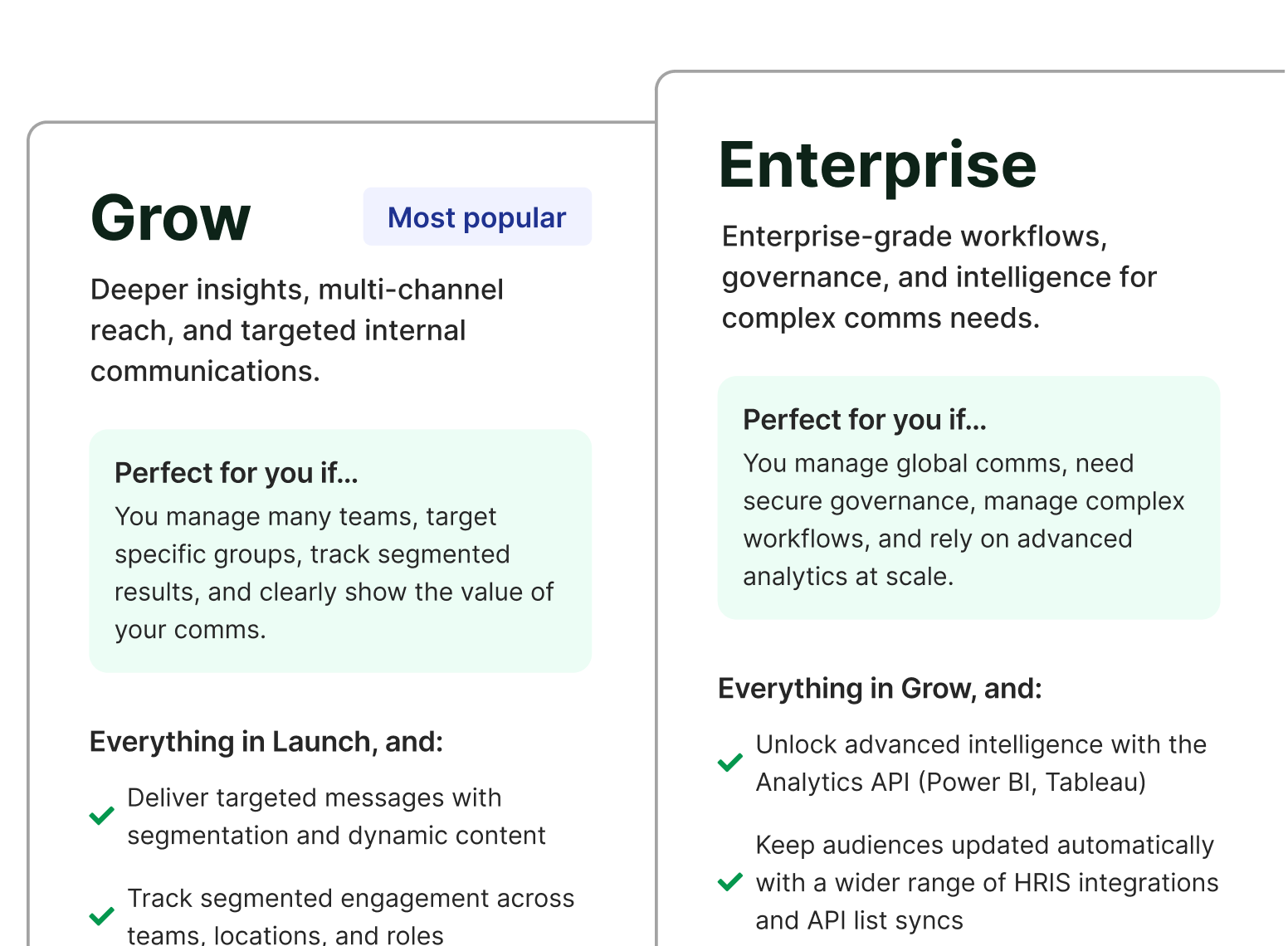
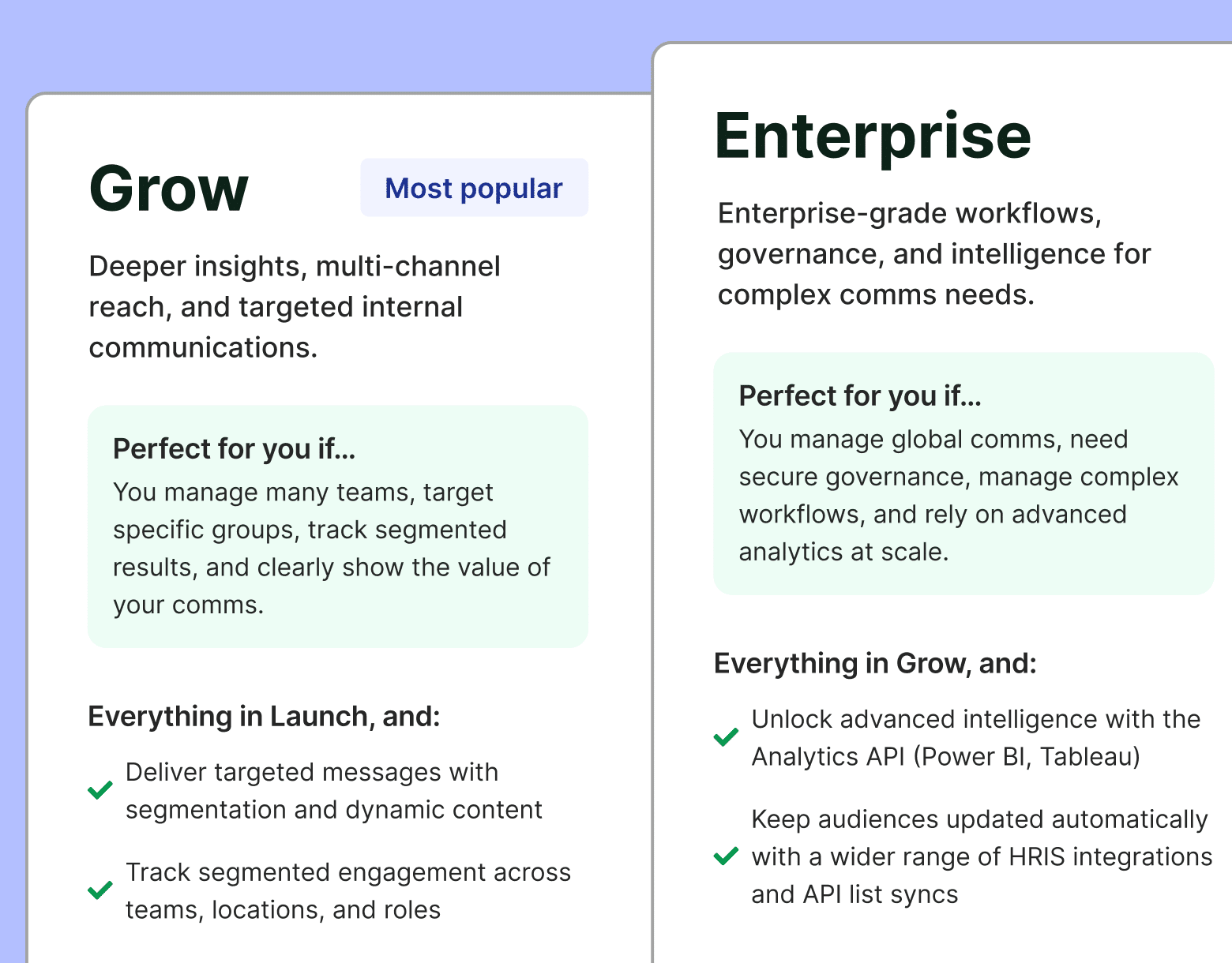
3. Align campaigns with organizational priorities
No matter the topic, whether you’re dealing with a culture driver, system adoption, strategy rollout, restructuring, or something else entirely, campaign-based communications should always support and connect back to business priorities.
In practice, this looks like:
- Directly connecting internal comms to business strategy, whether it’s a quarterly focus or the organization’s annual goals
- Speaking the same language by mirroring the same phrases that leadership presents to the organization to create reinforcement loops
Here’s an example rippling across today’s organizations. Let’s take the strategic priority of encouraging AI adoption. Here’s how internal comms could create a campaign to support this objective:
Campaign idea: “The AI Advantage” — Rather than sending ad hoc emails about AI training to encourage use, this campaign can tell a cohesive story about everyday AI usage to highlight and recognize employee success stories, demystify AI tools, and offer interactive learning opportunities.
Language used: Leadership might use words like “efficient and time savings” when referencing the advantages of AI. Mirror these descriptions throughout the campaign:
- “Efficiency is everyone’s job, and we’ll use AI to become more efficient, together.”
- “AI is how we create more time savings for the work that matters most.”
Additionally, using any specific phrases the leadership team uses and quoting them reiterates their perspective and reinforces the core ideas of the campaign in each email.
In situations where a defined strategic roadmap doesn’t exist (or hasn’t been communicated clearly), internal communicators can lean into other stable, recognizable traits of the business, including company values, employee experience themes, or mission statements.
4. Balance email with other comms channels
While email can serve as the core of the campaign, take a look at your organization’s comms channel mix and consider how best to complement and reinforce your emails through other channels. A multi-channel approach helps reinforce the narrative arc of the email campaign and reaches employees in multiple locations, meeting them where they are.
Channels that could pair nicely with your email campaign include:
- Chat reminders via Microsoft Teams or Slack
- Short videos, images, or infographics reiterating key points on your intranet homepage
- Manager toolkits to support conversations between managers and their reports
- Digital signage that captures key points and deadlines
- Team meetings and town halls
In a small organization (<500 employees) where I previously worked, we used email as our primary channel for communicating the bulk of campaign messaging. Then, we’d reiterate the key messages in all-hands meetings and follow up with key messages and deadline reminders in Slack posts after the all-hands. We would also encourage managers to share final deadline reminders in their team meetings and one-on-one meetings.
Regardless of your workflows, remember that the goal is not simply to copy and paste your emails across multiple channels. Many of these channels are not conducive to sharing extensive amounts of information. Supplementing email campaigns with additional channels should be used to reinforce key messages, provide deadline reminders, and offer tailored messaging to specific audiences as needed.
Modern internal comms and measurement tools
No design or technical expertise needed. Save time, increase engagement, and dazzle your employees with fun and interactive communications.
Explore all features

Real Examples of Internal Email Campaigns
Using the framework above, let’s examine some examples of thoughtful internal email series that transform updates into connected, interlinked employee journeys.
Change management campaign (4 email sequence)
Here’s an example of how to structure a change management email campaign sequence to communicate organizational change to employees. The goal is to drive awareness and adoption of a new tool, let’s say an expense reporting system.
Here’s how the campaign could look, with personalized internal emails and sequence order in mind:
| Overview | Goal / Outcome | Audience |
| Email 1: Give managers and team leads details about the change | Equip leaders to answer questions and cascade key messaging | Employees with direct reports |
| Email 2: Announce the new system and why the change is happening | Make all employees aware of the upcoming new system and how it relates to the organization’s “operational efficiency” priority | All staff |
| Email 3: Training-focused email focused on action | Train employees on the new tool | All staff, segmented by role access (admins, approvers, submitters) in the tool |
| Email 4: Share adoption metrics and celebrate new tool usage | Reinforce usage of the new tool; increase training numbers | All staff |
Additional channels to complement this sequence could include: An intranet post with key messages and links, chat reminders, and manager mentions during team meetings.
Why this works: This sequence cascades the change through the organization, prepares managers early in the process, and breaks down the change and action required to avoid overwhelm.
Culture/values campaign (3 email sequence)
Next, let’s take a look at a short sequence for a company values campaign, focusing on an organization that wants to embed its company values into daily work.
Here’s how the campaign could look, with audience segments and messaging sequence in mind:
| Overview | Goal / Outcome | Audience |
| Email 1: Share and reiterate company values and why they matter | Make all employees aware of the focus on company values and campaign to embed them into daily work | All staff |
| Email 2: Example of how each team is living values in practice (provided by team leads) | Spotlight relevant value-led stories within an employee’s team to inspire reflection and action to continue practicing values | Segmented by team |
| Email 3: Announce nomination form for digital values wall | Encourage employees to take action and share stories and examples to reinforce values | All staff |
Additional channels to complement this sequence could include: A blurb and reiteration of company values and key messaging in your internal newsletter email, and a values feature during an all-hands meeting.
Why this works: This sequence emphasizes the importance of company values to the organization, provides examples employees can grasp, and encourages ongoing participation to strengthen culture. It goes beyond simply stating, “Here are our values,” and fosters shared ownership.
Recognition and engagement campaign (4 email sequence)
And one more recognition internal email campaign example, with the goal of increasing participation during an employee recognition week event.
Here’s how the campaign could look, with internal email segmentation and messaging sequence in mind:
| Overview | Goal / Outcome | Audience |
| Email 1: Announce what’s coming | Build excitement by introducing employee appreciation week with a schedule of events | All staff |
| Email 2: Provide managers with ideas and talking points to recognize their teams | Equip managers with tools for personalizing appreciation efforts and celebrating their teams | People managers |
| Email 3: Company-wide kickoff | Launch day message from leadership expressing gratitude | All staff |
| Email 4: End of week recap | Reinforce employee appreciation through event recaps, photos, participation stats, and shoutouts | All staff |
Additional channels to complement this sequence could include a designated channel in your chat app for sharing photos from events, as well as a dedicated intranet section or full landing page.
Get powerful email analytics and reporting features
Know exactly who is opening and engaging with your employee communications and company newsletters.
Explore analytics & reporting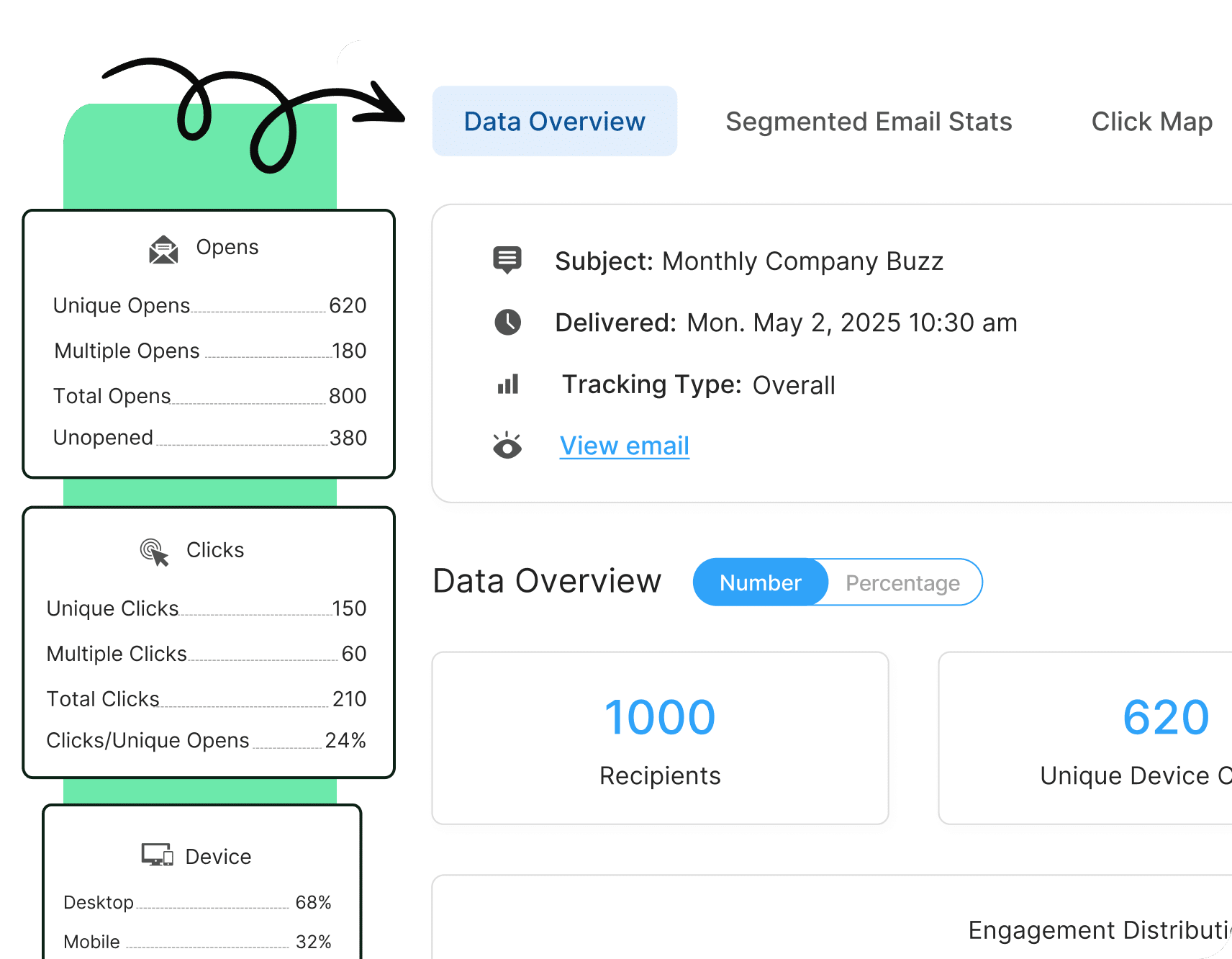
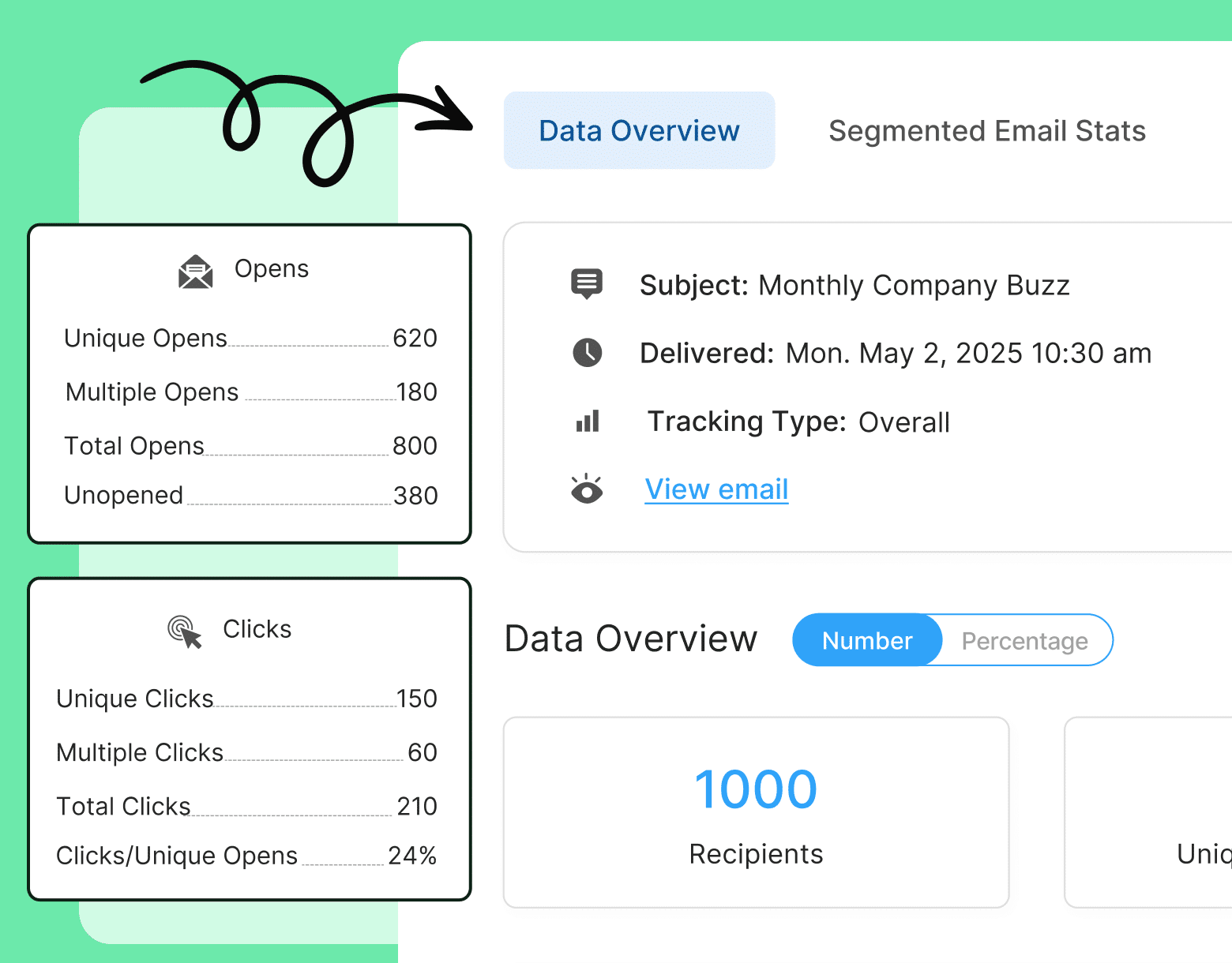
Measuring Success of Campaigns
The best way to evolve and improve your internal email campaigns? Measuring your success and adjusting accordingly. Here’s how:
Metrics: Open rate, CTR, read time, pulse surveys
Internal email metrics indicate whether employees are receiving, interested in, and engaging with our messages, which is crucial for evaluating the performance of a campaign. Internal email analytics to consider monitoring and tracking include:
- Internal email open rate: Did employees open your email? (If not, consider your internal email subject lines as a starting point for improvement.)
- Internal email CTR: Are employees engaging with your content? Clicking on links? Completing surveys?
- Internal email read time: Are employees consuming content and spending time with it, or are they opening emails, skimming, and closing the email before reaching the important information?
- Pulse survey results: How are employees directly responding to your messages? What feedback are they providing?
These metrics can help you gauge the effectiveness of each individual message in your campaign and determine where there are gaps in understanding to address.
Iteration via subject line testing
Internal email campaigns are always an opportunity to test, learn, and improve through testing. Comparing two versions of email subject lines, send times, and even action-driven wording can help you structure future campaigns based on lived success. When conducting version testing, ensure that you test one variable at a time to maintain data accuracy.
Dashboard reporting for campaign ROI
Internal comms email software tools like ContactMonkey help internal communicators visualize campaign performance and reporting to prove ROI of communications. For example, you can compare your current campaign performance against previous campaigns to gain a detailed look at open rates, click-through rates, audience engagement, and other email metrics, identifying areas for improvement and opportunity. Internal email reporting is a must for showcasing ROI.
Tools to Help You Implement Campaign Thinking
Manually creating email campaigns is time-consuming. Instead, try an internal communications email platform like ContactMonkey with all the features you need to implement campaign thinking, including:
Campaign planning templates
Every busy internal communicator knows one of the best ways to save time is with templates. With ContactMonkey, you can access a library of customizable templates for internal comms and edit, reuse, or duplicate them to speed up the campaign creation process. Plus, use your brand’s fonts, colors, and logos to create a well-branded experience.
ContactMonkey segmentation + analytics dashboard
ContactMonkey offers presentation-ready reports that show engagement by audience segment. You can benchmark performance across departments, roles, or geographies and share clear evidence of what’s working with your leadership team. And with data at your fingertips, you can adjust and experiment with future campaigns based on what you learn. For example, find the best time to send internal emails to your organization based on your data.
Grow Your Internal Email Impact with Campaigns
Use ad hoc internal emails for what they’re intended for: emergencies, time-sensitive updates, and topics that don’t require in-depth information beyond a single send.
Elevate your internal email strategy with structured, goal-driven campaigns, supported by the right tools that enable you to measure engagement and success, allowing you to refine your emails for the next campaign.
Our team is ready to help you learn more about one-off sending vs campaign approaches. Book a quick demo with one of our experts to understand how to power your practice with the right tools, today!
